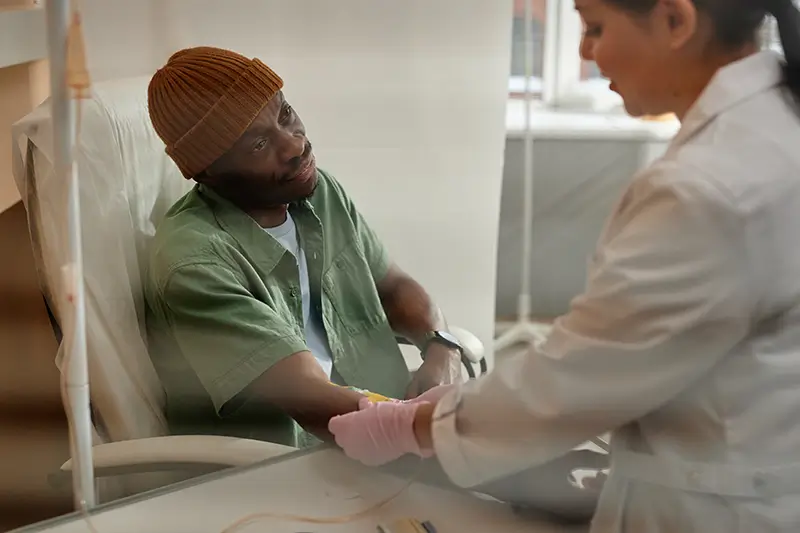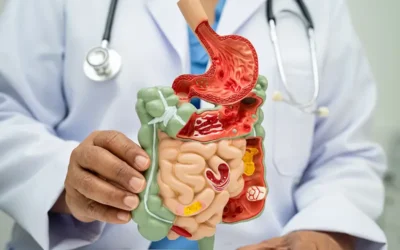An aggressive form of chemical drug therapy, chemotherapy is used to destroy rapidly growing cells in the body. Often called chemo, the treatment uses powerful chemicals to kill, slow down/prevent the growth of cancer cells which grow and divide much more quickly than other cells. In most cases, chemotherapy is used in combination with other therapies, such as surgery, radiation, or hormone therapy. Oncologists or cancer specialists devise a detailed treatment plan for their patients that involves this procedure. However, the effectiveness of treatment will depend on the type and stage of cancer and other related factors like – location of the cancer cells, previous cancer treatments undergone by the patient, overall health of the patient and the personal treatment preferences of the patients. Chemotherapy is considered a systemic treatment, which means it affects the entire body. Though chemotherapy is an effective way to treat many types of cancer, the treatment has its own risk of side effects. Some side effects are mild and treatable, while others can cause serious complications that can severely impact your quality of life. Chemotherapy, whether performed alone or in combination with other therapies, accounting for related performed procedures is vital to code selection. Physicians performing chemotherapy should correctly document the procedures in the patients’ medical records. Outsourcing billing and coding tasks to a reliable medical billing and coding company is a great way to simplify this documentation process.
How Chemotherapy Works and Why It Is Done
Our body is made of trillions of cells, which die off and multiply as part of the normal growth cycle. Cancer occurs when abnormal cells in the body multiply at a rapid, uncontrolled pace. However, in some cases, these cells grow into tumors or masses of tissue. Cancers are of different types which affect different parts of the body. If left untreated, these cells can spread rapidly.
Chemotherapy treatment is done to –
- Stop or prevent cell division
- Trigger apoptosis (suicide of cancer cells)
- Shrink a tumor before surgery
- Remove any remaining cancer cells and delay or prevent a recurrence (after surgery)
- Slow the progression of the disease
- Reduce symptoms in the later stages, even if a cure is unlikely
In some cases, chemo treatment is also done to treat conditions other than cancer like – bone marrow diseases (prepare for a bone marrow (stem cell) transplant) and immune system disorders (to control an overactive immune system in certain diseases, such as lupus and rheumatoid arthritis). There are certain side effects that occur during chemo therapy treatment which include – nausea, vomiting, pain, mouth sores, loss of appetite, hair loss, fever, fatigue, easy bruising and constipation. However, most of these side effects subside soon after the completion of the treatment.
Types of Chemotherapy
The type of chemo administered will vary and depend on the type, stage and severity of cancer. Different types of chemo include –
- Adjuvant chemotherapy – Usually administered after surgery, this type helps to kill cancerous cells that may remain undetected and help prevent recurrence of the cancer.
- Neo-adjuvant chemotherapy – This type of therapy is administered to shrink too large tumors to make it possible to remove them surgically.
- Palliative chemotherapy – This type of chemo is done for those cancers that have spread radically and are impossible to remove surgically. Physicians may use palliative chemotherapy to relieve symptoms, make complications less likely, and slow the cancer’s progress or stop it temporarily.
How Is the Procedure Administered?
Preparing for chemotherapy depends on the type of drugs received and how they will be administered. Physicians will give specific instructions to the patients to get ready for the procedure in advance. Physicians may recommend several tests and procedures to make sure your body is fit to receive chemo drug. Blood tests to check the kidney, liver and heart functions will be recommended by physicians. In addition, they may also recommend a dental check up to test the teeth for signs of infection. Treating existing infections may reduce the risk of complications during treatment, since some chemo drugs may reduce your body’s ability to fight infections. If there is any problem, physicians may postpone your treatment or select a different chemo drug and dosage that is safer for patients.
It is important to ask physicians what specific side effects are likely to occur during and after the chemo session so that patients can prepare in advance. Patients can arrive at their first chemotherapy treatment well-rested. They need to consume a light meal beforehand in case the chemotherapy medications cause nausea. In addition, patients need to take the help of a family member or friend to accompany them to and from their first chemo session as the medications injected can make patients sleepy or cause other side effects.
Most people will receive chemotherapy in a clinical setting. Chemotherapy drugs can be administered in different ways which include – infusions into an artery or vein, injections into the muscle or under the skin, injections into the fluid around your spinal cord or brain, by mouth (as tablets, liquid or capsules) and topically, onto the skin (as creams). Patients who are receiving the chemotherapy intravenously (into vein or artery) may require a minor surgical procedure to have a thin catheter (called a central line or port) implanted into a vein to make it easier to administer the drugs. The type of chemo drugs patients receive will depend on several factors like – type and stage of cancer, previous cancer treatments and overall health of the patient and extent of recovery after each treatment. The treatment schedules can be either continuous or it may alternate between periods of treatment and periods of rest to let the patient recover.
Medical billing and coding for chemotherapy can be challenging, as it involves numerous rules related to reporting the procedure accurately. Physicians administering chemotherapy must use the relevant CPT codes to bill for the procedure correctly. The CPT codes for chemotherapy include –
- 96360– Intravenous infusion, hydration; initial, 31 minutes to 1 hour
- 96361 – Intravenous infusion, hydration; each additional hour
- 96365– Intravenous infusion, for therapy, prophylaxis, or diagnosis (specify substance or drug); initial, up to 1 hour
- 96366 – Intravenous infusion, for therapy, prophylaxis, or diagnosis (specify substance or drug); each additional hour
- 96367 – Intravenous infusion, for therapy, prophylaxis, or diagnosis (specify substance or drug); additional sequential infusion of a new drug/substance, up to 1 hour
- 96368 – Intravenous infusion, for therapy, prophylaxis, or diagnosis (specify substance or drug); concurrent infusion
- 96369 – Subcutaneous infusion for therapy or prophylaxis (specify substance or drug); initial, up to 1 hour, including pump set-up and establishment of subcutaneous infusion site(s)
- 96370 – Subcutaneous infusion for therapy or prophylaxis (specify substance or drug); each additional hour
- 96371 – Subcutaneous infusion for therapy or prophylaxis (specify substance or drug); additional pump set-up with establishment of new subcutaneous infusion site(s)
- 96372 – Therapeutic, prophylactic or diagnostic injection (specify substance or drug); subcutaneous or intramuscular
- 96373 – Therapeutic, prophylactic or diagnostic injection (specify substance or drug); intra arterial
- 96374 – Therapeutic, prophylactic or diagnostic injection (specify substance or drug); intravenous push, single or initial substance/drug
- 96375 – Therapeutic, prophylactic or diagnostic injection (specify substance or drug); each additional sequential intravenous push of a new substance/drug
- 96376 – Therapeutic, prophylactic, or diagnostic injection (specify substance or drug); each additional sequential intravenous push of the same substance/drug provided in a facility
- 96377 – Application of on-body injector (includes cannula insertion) for timed subcutaneous injection
- 96379 – Unlisted therapeutic, prophylactic or diagnostic intravenous or intra-arterial injection or infusion
- 96401 – Chemotherapy administration, subcutaneous or intramuscular; non-hormonal antineoplastic
- 96402 – Chemotherapy administration, subcutaneous or intramuscular; hormonal antineoplastic
- 96405 – Chemotherapy administration; intralesional, up to and including 7 lesions
- 96406 – Chemotherapy administration; intralesional, more than 7 lesions
- 96409 – Chemotherapy administration; intravenous, push technique, single or initial substance/drug
- 96411 – Chemotherapy administration; intravenous, push technique, each additional substance/drug
- 96413 – Chemotherapy administration, intravenous infusion technique; up to 1 hour, single or initial substance/drug
- 96415 – Chemotherapy administration, intravenous infusion technique; each additional hour
- 96416 – Chemotherapy administration, intravenous infusion technique; initiation of prolonged chemotherapy infusion (more than 8 hours), requiring use of a portable or implantable pump
- 96417 – Chemotherapy administration, intravenous infusion technique; each additional sequential infusion (different substance/drug), up to 1 hour
- 96420 – Chemotherapy administration, intra-arterial; push technique
- 96422 – Chemotherapy administration, intra-arterial; infusion technique, up to 1 hour
- 96423 – Chemotherapy administration, intra-arterial; infusion technique, each additional hour
- 96425– Chemotherapy administration, intra-arterial; infusion technique, initiation of prolonged infusion (more than 8 hours), requiring the use of a portable or implantable pump
- 96440 – Chemotherapy administration into pleural cavity, requiring and including thoracentesis
- 96446 – Chemotherapy administration into the peritoneal cavity via indwelling port or catheter
- 96450 – Chemotherapy administration, into CNS (e.g., intrathecal), requiring and including spinal puncture
- 96521 – Refilling and maintenance of portable pump
- 96522 – Refilling and maintenance of implantable pump or reservoir for drug delivery, systemic (e.g., intravenous, intra-arterial)
- 96523 – Irrigation of implanted venous access device for drug delivery systems
- 96542 – Chemotherapy injection, subarachnoid or intra-ventricular via subcutaneous reservoir, single or multiple agents
- 96549 – Unlisted chemotherapy procedure
HCPCS Code
- G0498 – Chemotherapy administration, intravenous infusion technique; initiation of infusion in the office/clinic setting using office/clinic pump/supplies, with continuation of the infusion in the community setting (e.g., home, domiciliary, rest home or assisted living) using a portable pump provided by the office/clinic, includes follow up office/clinic visit at the conclusion of the infusion.
The outlook for a person receiving chemotherapy treatment will largely depend on the type, stage, and location of the cancer and their overall health. In some cases, it can achieve complete remission. Physicians will regularly monitor the effectiveness of treatment by conducting blood tests and adjust the treatment on that basis.
Medical billing and coding require adequate knowledge regarding appropriate codes and modifiers. Payer-specific medical billing is essential for correct and on-time reimbursement. With all the complexities involved, the support of a reliable and established medical billing service provider can be helpful for reporting chemotherapy procedures correctly.




